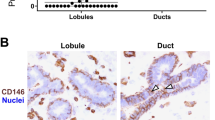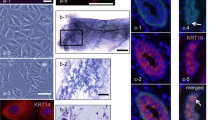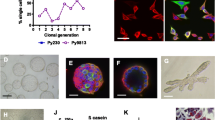Abstract
A new clonal cell line, EM-G3, was derived from a primary lesion of human infiltrating ductal breast carcinoma. The line consisted of cuboidal cells with occasional appearance of more differentiated branched cells apparently involved in cell-to-cell communication. The EM-G3 cells, population doubling time 34 h, are dependent on the epidermal growth factor. Multicolor fluorescence in situ hybridization (mFISH) analysis demonstrated a stable diploid genome with several genetic changes. Immunocytochemical analysis of EM-G3 in vitro revealed positivity for keratins (K) K5, K14, K18, nuclear protein p63, epithelial membrane antigen (EMA) and other proteins indicative of a pattern of mammary epithelium bipotent progenitors. Detection of integrins α-6, β-1, and protein CD44 by cDNA array also pointed to the character of basal/stem cells. In contrast, dominant cells in the human original tumor showed the luminal character (K18+, K19+, K5−, K14−, and p63−). However, cells with the immunocytochemical profile similar to that of cultured EM-G3 cells were found in minor clusters in the patient’s tumor sections. The EM-G3 cells formed limited tumors in nu/nu mice. The cells in mouse tumors were organized in primitive ductal-like structures consisting of 1–3 large central luminal-like cells (EMA+) surrounded by peripheral myoepithelial-like cells (p63+/EMA−). The large central cells gradually disintegrated, forming a pseudolumen. Apparently, EM-G3 cells are able to partially differentiate in vivo as well as in vitro. Our results indicate that EM-G3 cells were derived from a premalignant population of common progenitors of luminal and myoepithelial cells that were immortalized in an early stage of tumorigenesis.




Similar content being viewed by others
References
Lasfargues EY, Ozzello L (1958) Cultivation of human breast carcinomas. J Natl Cancer Inst 21:1131–1147
Lacroix M, Leclercq G (2004) Relevance of breast cancer cell lines as models for breast tumours: an update. Breast Cancer Res Treat 83:249–289
Jones C, Payne J, Wells D, Delhanty JD, Lakhani SR, Kortenkamp A (2000) Comparative genomic hybridization reveals extensive variation among different MCF-7 cell stocks. Cancer Genet Cytogenet 117:153–158
Wang CS, Goulet F, Lavoie J, Drouin R, Auger F, Champetier S, Germain L, Tetu B (2000) Establishment and characterization of a new cell line derived from a human primary breast carcinoma. Cancer Genet Cytogenet 120:58–72
O’Hare MJ (1991) Breast cancer. In: Masters JRW (eds) Human cancer in primary culture, 1st edn. Kluwer Academic Publishers, Dordrecht
Taylor-Papadimitriou J, Stampfer M, Bartek J, Lewis A, Boshell M, Lane EB, Leigh IM (1989) Keratin expression in human mammary epithelial cells cultured from normal and malignant tissue: relation to in vivo phenotypes and influence of medium. J Cell Sci 94:403–413
Pechoux C, Gudjonsson T, Ronnov-Jessen L, Bissell MJ, Petersen OW (1999) Human mammary luminal epithelial cells contain progenitors to myoepithelial cells. Dev Biol 206:88–99
Clayton H, Titley I, Vivanco M (2004) Growth and differentiation of progenitor/stem cells derived from the human mammary gland. Exp Cell Res 297:444–460
Deugnier MA, Teuliere J, Faraldo MM, Thiery JP, Glukhova MA (2002) The importance of being a myoepithelial cell. Breast Cancer Res 4:224–230
Bocker W, Moll R, Poremba C, Holland R, Van Diest PJ, Dervan P, Burger H, Wai D, Ina DR, Brandt B, Herbst H, Schmidt A, Lerch MM, Buchwallow IB (2002) Common adult stem cells in the human breast give rise to glandular and myoepithelial cell lineages: a new cell biological concept. Lab Invest 82:737–746
Birnbaum D, Bertucci F, Ginestier C, Tagett R, Jacquemier J, Charafe-Jauffret E: Basal and luminal breast cancers: basic or luminous? (review). Int J Oncol 25:249–258
Stingl J, Raouf A, Emerman JT, Eaves CJ (2005) Epithelial progenitors in the normal human mammary gland. J Mammary Gland Biol Neoplasia 10:49–59
DiRenzo J, Signoretti S, Nakamura N, Rivera-Gonzalez R, Sellers W, Loda M, Brown M (2002) Growth factor requirements and basal phenotype of an immortalized mammary epithelial cell line. Cancer Res 62:89–98
Gusterson B, Ross D, Heath V, Stein T (2005) Basal cytokeratins and their relationship to the cellular origin and functional classification of breast cancer. Breast Cancer Res 7:143–148
Gudjonsson T, Villadsen R, Nielsen HL, Ronnov-Jessen L, Bissell MJ, Petersen OW (2002) Isolation, immortalization, and characterization of a human breast epithelial cell line with stem cell properties. Genes Dev 16:693–706
Wellings SR, Jensen HM, Marcum RG (1975) An atlas of subgross pathology of the human breast with special reference to possible precancerous lesions. J Natl Cancer Inst 55:231–273
Petersen OW, Gudjonsson T, Villadsen R, Bissell MJ, Ronnov-Jessen L (2003) Epithelial progenitor cell lines as models of normal breast morphogenesis and neoplasia. Cell Prolif 36(Suppl 1):33–44
Dontu G, Al Hajj M, Abdallah WM, Clarke MF, Wicha MS (2003) Stem cells in normal breast development and breast cancer. Cell Prolif 36(Suppl 1):59–72
Al Hajj M, Wicha MS, Benito-Hernandez A, Morrison SJ, Clarke MF (2003) Prospective identification of tumorigenic breast cancer cells. Proc Natl Acad Sci USA 100:3983–3988
Ponti D, Costa A, Zaffaroni N, Pratesi G, Petrangolini G, Coradini D, Pilotti S, Pierotti MA, Daidone MG (2005) Isolation and in vitro propagation of tumorigenic breast cancer cells with stem/progenitor cell properties. Cancer Res 65:5506–5511
Matouskova E, Dudorkinova D, Krasna L, Vesely P (2000) Temporal in vitro expansion of the luminal lineage of human mammary epithelial cells achieved with the 3T3 feeder layer technique. Breast Cancer Res Treat 60:241–249
Krasna L, Dudorkinova D, Vedralova J, Vesely P, Pokorna E, Kudlackova I, Chaloupkova A, Petruzelka L, Danes J, Matouskova E (2002) Large expansion of morphologically heterogeneous mammary epithelial cells, including the luminal phenotype, from human breast tumours. Breast Cancer Res Treat 71:219–235
Hermanova M, Lukas Z, Kroupova I, Kleibl Z, Novotny J, Nenutil R, Pazourkova M, Brazdil J, Kren L, Dite P (2003) Relationship between K-ras mutation and the expression of p21WAF1/CIP1 and p53 in chronic pancreatitis and pancreatic adenocarcinoma. Neoplasma 50:319–325
Brezinova J, Zemanova Z, Ransdorfova S, Sindelarova L, Siskova M, Neuwirtova R, Cermak J, Michalova K Prognostic significance of del(20q) in patients with hematological malignancies. Cancer Genet Cytogenet 160:188–192
Li SY, Rong M, Grieu F, Iacopetta B (2006) PIK3CA mutations in breast cancer are associated with poor outcome. Breast Cancer Res Treat 96:91–95
Mayr D, Hirschmann A, Lohrs U, Diebold J (2006) KRAS and BRAF mutations in ovarian tumors: a comprehensive study of invasive carcinomas, borderline tumors and extraovarian implants. Gynecol Oncol (in press)
Campbell IG, Russell SE, Choong DY, Montgomery KG, Ciavarella ML, Hooi CS, Cristiano BE, Pearson RB, Phillips WA (2004) Mutation of the PIK3CA gene in ovarian and breast cancer. Cancer Res 64:7678–7681
Li SY, Rong M, Grieu F, Iacopetta B (2006) PIK3CA mutations in breast cancer are associated with poor outcome. Breast Cancer Res Treat 96:91–95
Wooster R, Futreal AP, Stratton MR (2005) Sequencing Analysis of BRAF Mutations in Human Cancers. Methods Enzymol 407:218–224
Tumbar T, Fuchs E (2006) Epithelial skin stemm cells. In: Lanza R, Gearhart J, Hogan B (eds) Essentials of stem cell biology, 1st edn. Elsevier, Amsterdam, Academic Press, New York
Clarke CL, Sandle J, Parry SC, Reis-Filho JS, O’Hare MJ, Lakhani SR (2004) Cytokeratin 5/6 in normal human breast: lack of evidence for a stem cell phenotype. J Pathol 204:147–152
Laakso M, Loman N, Borg A, Isola J (2005) Cytokeratin 5/14-positive breast cancer: true basal phenotype confined to BRCA1 tumors. Mod Pathol 18:1321–1328
Boecker W, Buerger H (2003) Evidence of progenitor cells of glandular and myoepithelial cell lineages in the human adult female breast epithelium: a new progenitor (adult stem) cell concept. Cell Prolif 36(Suppl 1):73–84
Deugnier MA, Faraldo MM, Janji B, Rousselle P, Thiery JP, Glukhova MA (2002) The EGF controls the in vivo developmental potential of a mammary epithelial cell line possessing progenitor properties. J Cell Biol 159:453–463
Rosfjord EC, Dickson RB (1999) Growth factors, apoptosis, and survival of mammary epithelial cells. J Mammary Gland Biol Neoplasia 4:229–237
Paine TM, Soule HD, Pauley RJ, Dawson PJ (1992) Characterization of epithelial phenotypes in mortal and immortal human breast cells. Int J Cancer 50:463–473
Smalley M, Ashworth A (2003) Stem cells and breast cancer: a field in transit. Nat Rev Cancer 3:832–844
Deng G, Lu Y, Zlotnikov G, Thor AD, Smith HS (1996) Loss of heterozygosity in normal tissue adjacent to breast carcinomas. Science 274:2057–2059
Lakhani SR, Chaggar R, Davies S, Jones C, Collins N, Odel C, Stratton MR, O’Hare MJ (1999) Genetic alterations in ‘normal’ luminal and myoepithelial cells of the breast. J Pathol 189:496–503
Marx J (2003) Cancer research. Mutant stem cells may seed cancer. Science 301:1308–1310
Reya T, Morrison SJ, Clarke MF, Weissman IL (2001) Stem cells, cancer, and cancer stem cells. Nature 414:105–111
Wenger SL, Senft JR, Sargent LM, Bamezai R, Bairwa N, Grant SG (2004) Comparison of established cell lines at different passages by karyotype and comparative genomic hybridization. Biosci Rep 24:631–639
Acknowledgments
We thank Mrs. Eva Taislova for excellent technical assistance. This work was supported by grants NR8145–3 and NR8345–4 from the Grant Agency of the Ministry of Health of the Czech Republic, Grant No. 93/2005/C from the Grant Agency of Charles University, Project AVOZ50520514 from the Academy of Sciences of the Czech Republic, and Research Project MSM0021620808 from the Ministry of Education, Youth and Sports of the Czech Republic
Author information
Authors and Affiliations
Corresponding author
Rights and permissions
About this article
Cite this article
Brozova, M., Kleibl, Z., Netikova, I. et al. Establishment, growth and in vivo differentiation of a new clonal human cell line, EM-G3, derived from breast cancer progenitors. Breast Cancer Res Treat 103, 247–257 (2007). https://doi.org/10.1007/s10549-006-9358-x
Received:
Accepted:
Published:
Issue Date:
DOI: https://doi.org/10.1007/s10549-006-9358-x




